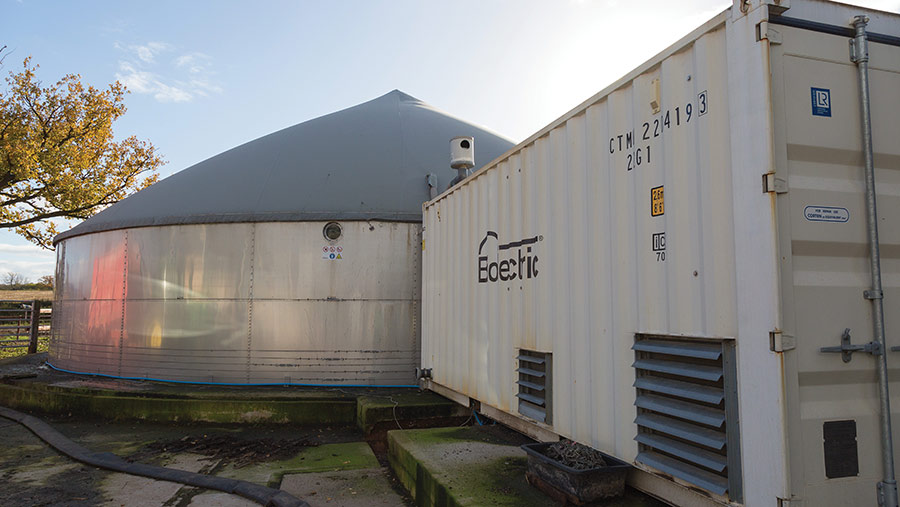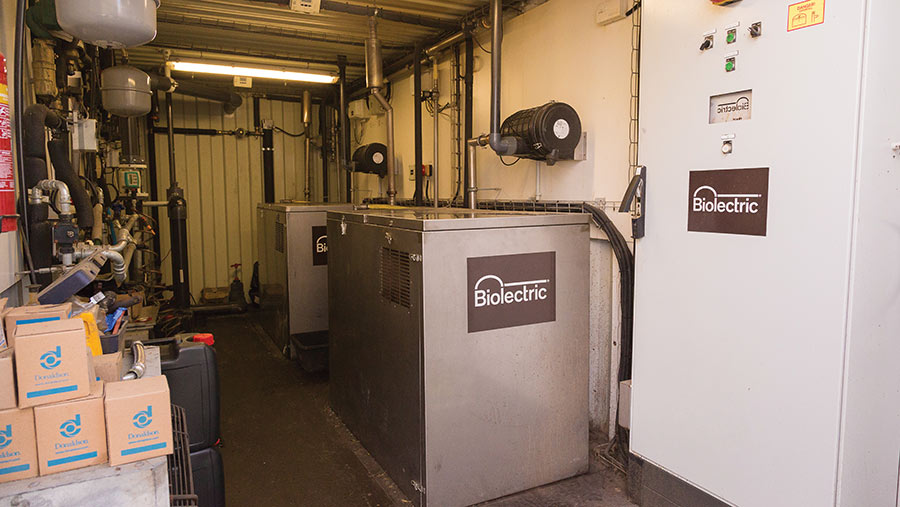How a slurry digester is helping cut energy costs by 85%
 Court Farm biodigester © MAG/Judith Tooth
Court Farm biodigester © MAG/Judith Tooth A Gloucestershire dairy farm has slashed monthly energy bills by using a farm-scale anaerobic digester, alongside solar panels, to produce electricity.
The technology employed at Court Farm, Kempley, also produces heat as a valuable by-product and improves slurry quality.
The investment is on track for a seven-year payback and is part of a range of measures Richard and Sarah Carter, who farm in partnership with Sarah’s parents, Calvin and Rachele Pugh, have put in place in recent years to improve efficiency and cow comfort.
See also: Why two systems are running separate heifer milking groups
The family’s housed herd of 260 pedigree Holsteins are milked using four robots, installed in 2017 along with 60 cubicles for a separate first-lactation heifer group.
More recently, housing ventilation has been improved with the installation of helicopter and boxed fans, and two robotic slurry collectors have replaced automatic scrapers, resulting in cleaner cows.
Farm facts: Court Farm, Kempley, Gloucestershire
- 260 pedigree Holsteins
- Breeding own replacements
- Partial mixed ration of grass and maize silage topped with bought-in concentrate
- Average yield 12,800 litres, at 4.16% butterfat and 3.43% protein
- 4 Lely robots
- 100ha grass and maize (plus 20ha extra maize land rented)
- 150 beef cattle
Slurry technology
A 33kW Biolectric mono digester was installed in 2019. This can run on a single feed stock such as slurry, whereas larger-scale digesters require an additional feed crop.
“I saw a headline that said, ‘Make money from s**t’. That turns your head – we could make energy from a waste product and have a better product at the end. It was a no-brainer,” says Richard.
The digester was integrated with the existing slurry system, as well as digging a further reception pit and renewing underground pipework.
The slurry is collected in a reception pit and pumped to the digester several times throughout the day.
Levels are monitored by means of a pressure sensor and computerised calculations, to ensure the correct amount of slurry goes in and comes out.
The outflow of digested slurry is gravity fed; a valve opens for two minutes, before the level is measured again and more slurry is pumped in.

Court Farm biodigester room © MAG/Judith Tooth
Slurry separator
Slurry is separated into solid and liquid fractions using a screw press. The solid part is recycled for bedding and the liquid part used as fertiliser.
Prior to this, the farm had a basic slurry separating system, and it was the opportunity to upgrade this that was the initial driver to invest.
“We wanted to try out recycled manure solids (RMS) for bedding, rather than using sawdust, to save on costs. We could use more of this for free to give the cows better comfort,” says Richard.
The slurry is separated daily, with 85% of the solid fraction used as RMS in the cubicle housing.
This makes its way back into the digester in a repeating loop and, because it is not an inert substance, it helps feed the bugs in the digester.
Mattresses are topped up with a shallow layer of RMS using a JCB fitted with a bedding dispenser bucket.
The remainder is stockpiled for use as a soil conditioner high in organic matter.
The liquid portion has a lower dry matter (DM) than raw slurry, he says.
Recent analysis showed the raw slurry was 10.2% DM, with total nitrogen (N) of 4%, and the digested slurry, 9.5% DM, with 4.3% total N.
Slurry is applied to grassland using a dribble bar attached to an umbilical system. “We want to cut [silage] within 28 days, so it’s only a light application,” he says.
Cost and savings
The Biolectric system cost £229,000, and total cost with the separator was £300,000. “We have 50kW of solar as well and, between that and the digester, we produce 85% of our energy needs,” Richard says.
“I like the digester to produce 20,000kW/month. It uses a bit to run itself – about 3,000kW/month – so the available electricity is 16,000-17,000kW/month.
“Our electricity bill would be £4,500/month in peak months, and about 85% of that is covered.”
A by-product of running the engines powering the digester is surplus heat.
This is used to heat the milking robot rooms for frost protection. It also warms water for calf feeding and bulk tank washing, and heats the farmhouse.
The digester was operational just before payments under the Feed-in Tariff closed.
This means the farm receives 4.5p/kW for every kW produced, for 20 years. A claim has been made for the Renewal Heat Incentive, but so far is ongoing.
Maintenance
The digester engines have to be serviced every 800 hours. This works out at 20-30 minutes once a month, and is done in-house.
“It’s a bit like the robots – you can’t just put it in and forget about it,” says Richard. “You get training at installation, and I’m notified via text if there is a problem.
“I think you’ve got to have an interest in it. I have basic knowledge in mechanics and electronics, so I’m OK with it.”
Since Brexit and the Covid-19 pandemic, it has been harder to get parts for the digester as they have to be shipped from Belgium as part of the service contract (which consists of quarterly maintenance visits, breakdown cover and spare parts).
However, Richard takes a pragmatic approach: “If anything does go wrong, we have to buy electricity, that’s all,” he says.
The numbers:
Milk from forage (litres): 4,650
Cuts of silage a year: 6
Persistency of perennial ryegrass leys (years): 5
Herd replacement rate (percentage): 26
